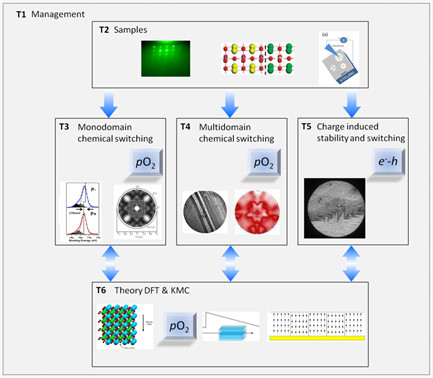Chemical switching of surface ferroelectric topology
« Back to the Group page « Back to the Contracts page
Project overview
The fundamental property of ferroelectric (FE) materials is their electrically switchable spontaneous polarization below the Curie temperature. However, the direction of the polarization in FE thin films is not only the result of an external electrical potential difference since it usually results from the minimization of the electrostatic energy in the whole sample. The polarization charge at the surface can be screened through a variety of mechanisms including extrinsic screening by adsorbate species, intrinsic screening by defects or free charge carriers in for example adjacent electrodes, surface and near surface structural changes (rumpling, relaxation and reconstruction) and by domain ordering which reduces the energy of the system by screening the depolarizing field through ordering of the FE domains with anti-parallel polarization.

- The chemical potential can also switch the polarization.
- Conversely, the polarization can influence surface chemical reactions.
It has been suggested that oxygen vacancies stabilize negative polarization, i.e. polarization pointing inwards. The topology of the surface FE order is therefore a complex interaction of the chemical and electronic environment.
In this project, photoelectron spectroscopy with energy, wave-vector and spatial resolution will be used to study the electronic and chemical structure of the FE topology and the mechanisms responsible for chemically induced switching. Surface composition by high resolution XPS and band structure determination by ARUPS will be compared with theory. Structural determination will include electron diffraction (LEED, RHEED) and X-ray photoelectron diffraction (XPD), while the surface morphology, FE topology and chemistry will be assessed by scanning probe microscopy (SPM) techniques and by low energy electron microscopy (LEEM) and photoelectron emission microscopy (real and reciprocal space PEEM). The project will advance understanding of the electronic, structural, and compositional origins of chemical switching of polarization. It will explore the chemical potential-temperature phase diagrams through the use of atomic oxygen and vicinal surfaces. Finally, it will furnish an understanding of the switching chemistry vital to a wide range of applications such as ferroelectric enhanced catalysis and photolysis, chemical sensing, screening mechanisms in oxide based electronics.Information
Funding
- Project ANR Blanc International II – Edition 2012 – France/Roumanie
Coordination
- Dr. Nick Barrett — CEA, IRAMIS, SPCSI, France
- Dr. Cristian Teodorescu — NIMP, Magurele, Roumanie
Specifications
- Funding amount : 332 837 euros
- Project duration : 36 mois
Related Open Positions
- Post-doc Position at CEA, IRAMIS, SPCSI — deadline: 1st March 2013 (download position description).





